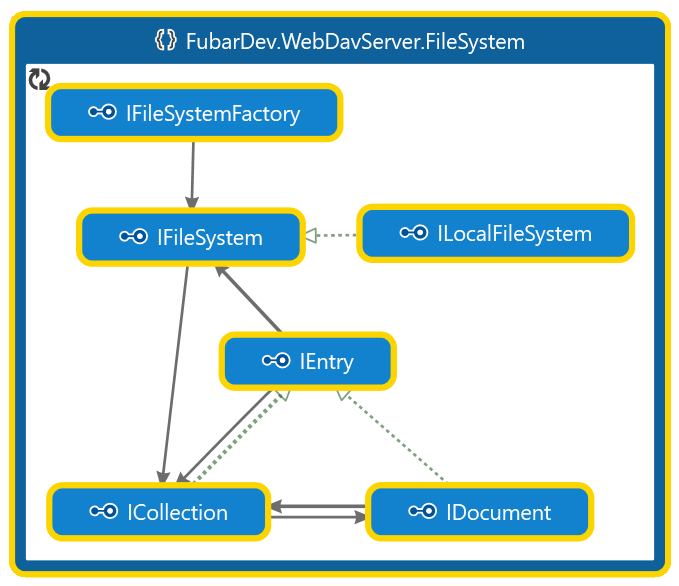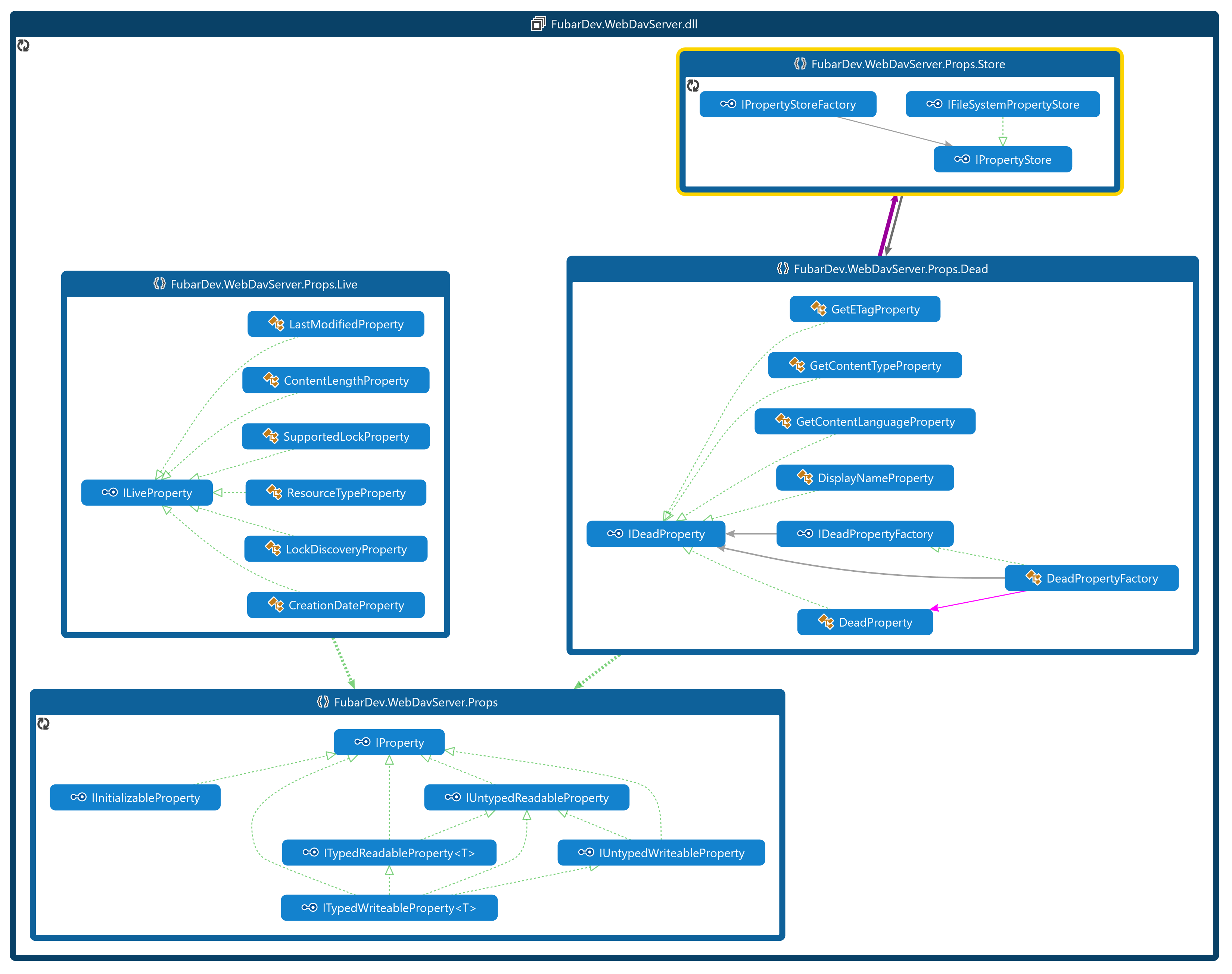Project overview
We will start with a simple directory based overview of the WebDAV server project.
| Path | Description |
|---|---|
api |
API documentation |
articles |
The articles for the documentation |
docs |
The compiled documentation |
images |
Images for the documentation |
src |
The source code |
src/FubarDev.WebDavServer |
The core WebDAV server assembly |
src/FubarDev.WebDavServer.FileSystem.DotNet |
A file system for the WebDAV server using System.IO |
src/FubarDev.WebDavServer.FileSystem.InMemory |
A file system for the WebDAV server storing all data in memory only |
src/FubarDev.WebDavServer.FileSystem.SQLite |
A file system for the WebDAV server storing all data in a SQLite database |
src/FubarDev.WebDavServer.Locking.InMemory |
A ILockManager implementation that holds its locks only in memory |
src/FubarDev.WebDavServer.Locking.SQLite |
An ILockManager implementation that holds its locks only in an SQLite database |
src/FubarDev.WebDavServer.Props.Store.InMemory |
A property store implementation that holds all dead properties in memory only |
src/FubarDev.WebDavServer.Props.Store.TextFile |
A property store implementation that stores the dead properties in a JSON text file |
src/FubarDev.WebDavServer.Props.Store.SQLite |
A property store implementation that stores the dead properties in an SQLite database |
src-doc |
Project files for docfx |
test |
Test projects |
third-party |
Third party library |
tools |
binary tools directory |
webdav-docs |
WebDAV specifications |
Namespaces
| Namespace | Description |
|---|---|
| FubarDev.WebDavServer | Common interfaces and classes of global interest |
| FubarDev.WebDavServer.Dispatchers | WebDAV class interfaces and dispatchers to their handlers |
| FubarDev.WebDavServer.Engines | Some commonly used engines. The only one here is currently RecursiveExecutionEngine. |
| FubarDev.WebDavServer.FileSystem | The interfaces and classes for the underlying file system support |
| FubarDev.WebDavServer.Formatters | The formatter for WebDAV XML responses |
| FubarDev.WebDavServer.Handlers | The interfaces for the handlers of the HTTP WebDAV methods |
| FubarDev.WebDavServer.Handlers.Impl | The default implementations of the interfaces for the handlers of the HTTP WebDAV methods |
| FubarDev.WebDavServer.Locking | The interfaces and classes the LOCK/UNLOCK support for WebDAV |
| FubarDev.WebDavServer.Model | The model for the WebDAV XML messages |
| FubarDev.WebDavServer.Model.Headers | The model for the WebDAV HTTP headers |
| FubarDev.WebDavServer.Props | The interfaces and classes for the underlying WebDAV property support |
| FubarDev.WebDavServer.Props.Converters | The interfaces and classes for WebDAV property converters that support conversion between a given value and an XElement |
| FubarDev.WebDavServer.Props.Dead | The interfaces and classes for the support of dead properties |
| FubarDev.WebDavServer.Props.Filters | Filters for properties used by the PROPFIND implementation |
| FubarDev.WebDavServer.Props.Generic | Implementations of generic typed WebDAV properties |
| FubarDev.WebDavServer.Props.Live | The interfaces and classes for the support of live properties |
| FubarDev.WebDavServer.Props.Store | The interfaces and classes for the a storage of dead properties (and EntityTag) |
| FubarDev.WebDavServer.Utils | Utility classes |
File system
A file system implementation starts with a IFileSystemFactory. It's used to create an instance of an IFileSystem for a given user.
The file system consists of a root ICollection which contains child ICollections and IDocuments. Both inherit from a common interface IEntry.

WebDAV properties
WebDAV knows two types of properties, live and dead properties. The dead properties must be stored using a IPropertyStore. The property store is created using the IPropertyStoreFactory for a given IFileSystem.
Every property should at least implement ILiveProperty or IDeadProperty. That a dead property isn't writeable is a design decision to allow storing an entity tag as dead property too.
The ITypedReadableProperty`1 and ITypedWriteableProperty`1 interfaces are convenience interfaces that allow accessing the dead property value without the need to handle all the XML fluff.

Locking
The locking functionality consists of the following main parts:
-
This is the interface used to manage WebDAV locks. It ensures that lock conflicts are detected and stored.
-
This is the base interface for all lock related information. It's implemented by both the Lock and IActiveLock classes.
-
This is the class that contains all information about a lock that the caller wants to create. It's created by a
LOCKrequest or any other request that creates an implicit lock. -
This interface contains all information about an active lock, like e.g. the state token, the time this lock was issued and when it expires.

xml:lang behaviour
The RFC4918 specification, section 4.4 explicitly states that it's not possible to define the same property twice on a single resource. This means, that xml:lang isn't used to provide multi-language translations. Instead, it's just an indicator for the language of the properties value.
The xml:lang property is handled in the following way:
- Live properties never return an
xml:lang - The
getetagproperty never returns anxml:lang - The
getcontenttype, andgetcontentlanguagemay return anxml:langeven though it doesn't make sense for them - The
xml:langattribute of a dead property element has precedence over thexml:langproperty of theDAV:propselement - A
PROPFINDdoesn't usexml:langat all - A
PROPPATCHsetrespects the transmittedxml:lang - A
PROPPATCHremovedoesn't usexml:lang